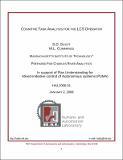Cognitive Task Analysis for the LCS Operator
Author(s)
Scott, S. D.; Cummings, M. L.
DownloadHAL2006-01.pdf (378.8Kb)
Other Contributors
Massachusetts Institute of Technology. Dept. of Aeronautics and Astronautics. Humans and Automation Laboratory
Metadata
Show full item recordAbstract
The following Tables and Figures detail the cognitive task analysis (CTA) performed to
determine the information requirements needed to support a single operator located aboard the
futuristic Littoral Combat Ship (LCS). This operator is responsible for controlling four
underwater unmanned vehicles in conjunction with a UAV operating on a shared network.
• Table 1 is a scenario task overview that breaks the overall mission into 3 phases
(planning, execution, and recovery) and then details the subtasks for each of the 3
mission phases.
• Figure 1 is an event flow diagram that demonstrates what events must occur in a temporal
order for each of the 3 phases. There are three basic event types in Figure 1: 1) a loop (L)
that represents a process that occurs in a looping fashion until some predetermined event
occurs, 2) a decision (D) that represents some decision that is required from the LCS
operator, and 3) a process (P) which requires some human-computer interaction to
support the required tasks. In each event block, an alphanumeric code is included which
labels that particular event type (L#, D#, P#). This label is important because later
information requirements will be mapped to one of these events.
• Table 2, which details the situation awareness (SA) requirements for the LCS Operator
for each of the 3 mission phases and associated subtasks. Each of these SA requirements
is mapped directly to one or more events in Figure 1.
Because the decisions in Figure 1 represent critical events that require detailed understanding of
what information and knowledge is needed to support the operator’s decision-making process,
decision ladders were constructed for the diamonds and loops in Figure 1 that correspond to an
involved decision process to resolve the question being posed at that stage in the event flow
(Figures 2-4). Decision ladders are modeling tools that capture the states of knowledge and
information-processing activities necessary to reach a decision. Decision ladders can help
identify the information that either the automation and/or the human will need to perform or
monitor a task. Decision Ladders, illustrate the need not only for the same information identified
by the cognitive task analysis, but the need for several other pieces of information such as the
need for visual or aural alerts in contingency situations. In Figures 2-4, three versions are
included that detail (a) the basic decision ladder, (b) the decision ladder with corresponding
display requirements, and (c) the decision ladder with possible levels of automation.
• Figure 2 represents the automated target recognition (ATR) decision ladder (D3 from
Event Flow): (a) decision ladder, (b) decision ladder with corresponding display
requirements, and (c) decision ladder with possible levels of automation.
• Figure 3 shows the decision ladder information and knowledge requirements for the
sentry handoff (L3 from Event Flow).
• Figure 4, the UUV Recovery Decision Ladder (D7 from Event Flow), illustrates what
information is nominally needed. Since this phase was not a major focus, the decision
ladder is not as detailed as it could be. This should be a point of focus in Phase II.
Lastly Figure 5 demonstrates the coordination loop that must occur in the case where a handoff
failure occurs (for a number of reasons to include equipment failure, communication delays, etc.)
Again, because the multi-player coordination issues are not a primary focus in Phase I but are a
significant consideration for any follow-on phases.
Description
In support of Plan Understanding for Mixed-initiative control of Autonomous systems (PUMA)
Date issued
2006Publisher
MIT Humans and Automation Laboratory
Series/Report no.
HAL Reports;HAL2006-01